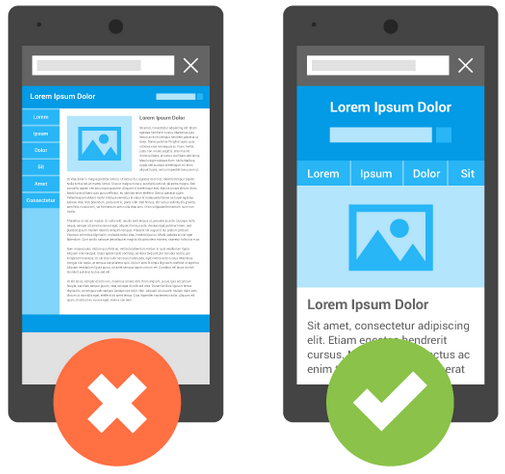Google have officially stated that Responsive Web Design is their preferred choice for websites, and offer web designers and developers advice in order to optimise websites for any search engine algorithms they launch.
For this reason, a responsive web design is the best choice for search engine optimisation; but why exactly does Google prefer responsive web design over any other forms of website design.
Each day, more smartphones and tablets are activated and used on a daily basis; with more websites adopting mobile-optimised content and website designs. In fact, research has shown that tablet ecommerce sales are growing fast, showing 79% compared to the smartphones 43% for 2014.
After “mobilegeddon“ on April 21st 2015, Google have started using responsive web design as a ranking factor. This means that any businesses with a responsive website will find this is adding to their higher search rankings on Google.
For this reason, a responsive web design is the best choice for most businesses; but why exactly does Google prefer responsive web design over any other forms of website?
Google recommend: “webmasters follow the industry best practice of using web design, namely serving the same HTML for all devices, using media queries to decide rendering on each device.”
But it’s not just Google; Bing and Yahoo love responsive web design too. It can be easy to forget that Google isn’t the only search engine that people use; as whilst Google dominates the competition, there’s a good portion of your audience who are no doubt using alternatives. However, Google is the only one who really has the power and influence to change our practices around SEO.

What are the alternatives?
Adaptive Web Design
Adaptive designs are similar to responsive sites, in that they allow sites to be viewed on different screen sizes.
However, responsive design allows for flexible and fluid changes in the design to adjust to the exact size of the screen, whereas adaptive designs rely on predetermined screen sizes; which makes it a lot more difficult to cater for all audiences.
Separate m-dot mobile website
One option is to have a separate mobile website under “m.yoururl.co.uk”, or something along those lines. This mobile site can provide a custom user experience for those on mobile or tablet devices.
The problem here, is that it doesn’t adapt to any device, but provides a mobile-optimised interface for interaction. It’s still better than nothing, but the fact it has a different URL brings up problems.
The site will need redirects to direct users to either the mobile or desktop site, and you will have to be careful when sharing and linking to certain pages to ensure customers get the right page for their situation. With these redirects and careful planning around links, it makes management of the site more complex and difficult than it needs to be. You’re essentially managing two different websites entirely.
Ignore mobile users
The last alternative, is to simply forget about mobile users, and force them to use your desktop site on your phone.
In 2015, this simply should no longer be an option; but you’d be surprised at how many businesses are happy to allow their customers to struggle to use their site on their chosen mobile device.
If your business makes the leap and goes for a responsive web design, you could sail past your competitors, and open your business to a new audience who are shopping or browsing from their phone or tablet.
Why does Google recommend Responsive Web Design?
At the end of the day, there has to be a reason Google recommends responsive web design. Mobile websites and adaptive designs support mobile devices, so why has Google gone with responsive web design as the pinnacle of internet browsing?

User Experience
Google wants users to have a good experience after leaving the search engine; and this means they will rank websites with the best user experiences higher.
Google deem responsive web design as the ultimate user experience as far as web design goes, and so it only makes sense for Google to rank responsive web designs higher.
More Mobile Users
There are now more mobile devices around the world than ever, with mobile internet usage officially overtaking desktop usage in 2015, which means brands must accommodate for mobile users who want the same experience wherever they may browse.
Responsive sites use a single URL
If you have a mobile website, then you will want to share or send something like “m.yoururl.co.uk” to your mobile customers. However, this would look bad to desktop users, and a normal desktop URL would appear bad on a mobile, without any form of redirection.
With a responsive web design, it uses the same URL for everyone, which means there’s no miscommunication between you and the customer, alongside customers who may be sharing links to products or content themselves.
In addition, it’s great for SEO purposes, as the website content will get indexed faster and more efficiently by Google, due to the fact that a single URL keeps it easier for Google’s algorithms to index the website. For more information on mobile marketing, read our blog on why you need to start now.
Minimal hassle and upkeep
Because a responsive design has a single URL, and no mobile-specific pages to worry about, it means less frustration and work to be done overall.
You don’t have to optimise both desktop and mobile pages for SEO; it counts for both, essentially halving the work-load. There’s no cross-device frustration for users and the business in question, meaning customers won’t attempt to navigate the wrong site on the wrong device.
Despite the fact costs can often be higher when opting for a responsive website, it quickly earns back the cost and causes less trouble in the long run.
Responsive designs often look the best
There are many ugly and off-putting websites out there that try to do too much at the same time. With a responsive design, websites often reduce the number of things needed to appear on screen, to ensure that all of the necessary parts do in fact appear on screen.
For instance, if you compiled every single button and design feature of a desktop site made for a 1920×1080 size screen onto a mobile phone with half the pixels, it’s not going to look great. With a responsive design, it would compress the site to what is really needed, and that is exactly what Google wants to see. Google does not want to send users to poorly designed websites.
Google own Android
Of course, Google owns the most popular mobile operating system in the world – Android.
Ensuring that people have a good experience browsing the web on their mobile or tablet device means that more people will use their Android devices for different things.
Diverse Devices
Now that mobile devices and tablets are so popular, there are simply endless ways for people to view websites.
Phones and tablets have screens ranging from 320 × 480 to quad HD 1440 x 2560, and many of them have different aspect ratios and other issues that mean websites look completely different on various devices. The biggest players in the mobile device and operating system space are Android and Apple devices, with Windows, Firefox, Blackberry, and many more competing. Responsive web design ensures it caters for all of these. An adaptive site would only cater to a select few, and even a mobile website would struggle to suit with a large percentage of them.
The difference between Android phones and iPhones is that with iPhones, there’s only a handful of different devices, and two new devices launched at any one time. They all have similar screens and similar specifications, which makes it easy to make websites for.
With Android, there are thousands of different devices out there, from phones with 4 inch screens to 12 inch tablets. This means responsive web design is the best way to ensure the web is suitable for these popular devices, and it also serves Google in that it helps encourage adoption of Android phones.
Encourage adoption of the Google ecosystem
The more people that shop on an Android device means that more people will use Google apps, and more people will shop using Google Wallet to shop instead of PayPal or their credit card.
Despite the fact Google have access to more and more of our data than ever, and that they are quickly becoming a brand that is overtaking the globe; they seem to be mostly encouraging practices that do help the consumer, and any internet user in general. How long this will last however, is a question for another time.
Becoming a standard
With so many ways to build a website, and configure them for the device, Google is attempting to create a certain standard people can come to expect when they search Google.
When a user searches, Google wants to provide them with the best content possible; and are therefore looking to rank responsive sites that serve the public the best at the top. Whilst recommending a responsive design to serve this purpose, the weight Google’s opinions has is that it has a wider impact on the web. This means Google has the influence to create a new standard format for the internet at large.
Overall, Google is serving both the public, and its own interests. But responsive web design has so many advantages for both businesses and internet users that it has become a no-brainer for many brands looking to expand their audience beyond just desktop users.
For more information, read our blog below:
Responsive Web Design: Mobile Website Examples for 2015
Why we listen to Google’s recommendations
Without support from Google, many websites and brands can lose out on a lot of traffic, and inevitably lose out on a lot of business.
Google has almost become the “home” of the web. It’s used daily by people who are looking for products to buy, looking for places to visit, looking for brands they love, and often used as an alternative to entering in a particular website as a URL. Millions of people use Google for countless reasons, and this is why it’s so important to rank there. And a responsive web design is the latest way to rank highly, but there are many more.
Otherwise, Google are genuinely attempting to improve how people interact with the internet at large, and produce a fluid and rewarding experience for many. For this reason, a responsive web design is the best choice for any brand looking to future-proof their website, and ensure that customers on any possible device can browse the website.
If you’re considering redesigning your site to be responsive, or are looking to build a new responsive website, get in touch with the team here at Xanthos who have 13 years’ experience in designing and developing sites that get noticed on Google.













